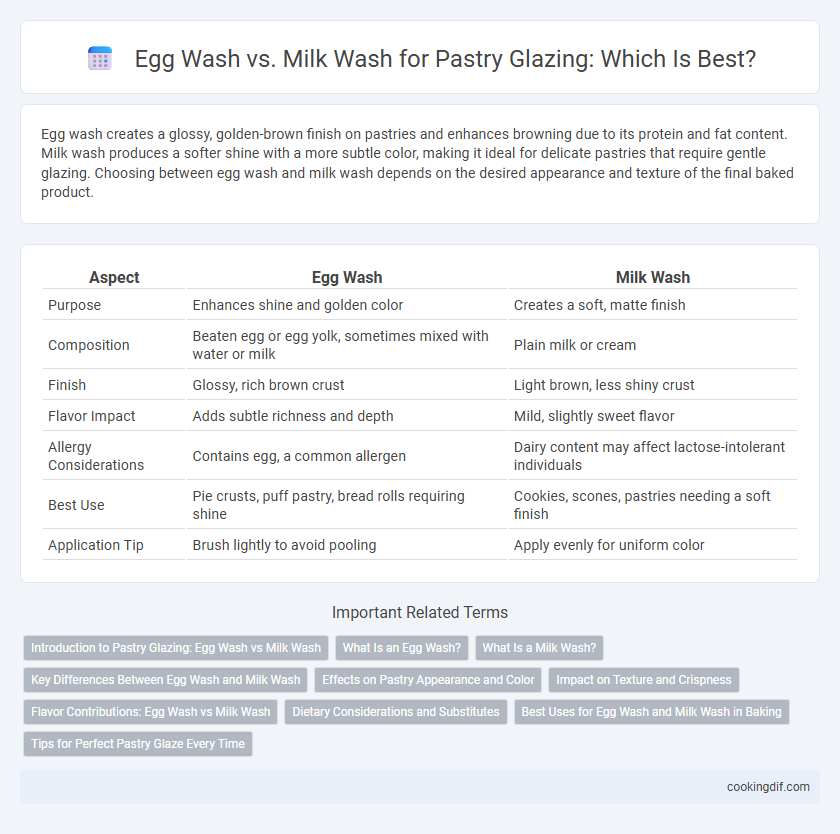Egg wash creates a glossy, golden-brown finish on pastries and enhances browning due to its protein and fat content. Milk wash produces a softer shine with a more subtle color, making it ideal for delicate pastries that require gentle glazing. Choosing between egg wash and milk wash depends on the desired appearance and texture of the final baked product.
Table of Comparison
| Aspect | Egg Wash | Milk Wash |
|---|---|---|
| Purpose | Enhances shine and golden color | Creates a soft, matte finish |
| Composition | Beaten egg or egg yolk, sometimes mixed with water or milk | Plain milk or cream |
| Finish | Glossy, rich brown crust | Light brown, less shiny crust |
| Flavor Impact | Adds subtle richness and depth | Mild, slightly sweet flavor |
| Allergy Considerations | Contains egg, a common allergen | Dairy content may affect lactose-intolerant individuals |
| Best Use | Pie crusts, puff pastry, bread rolls requiring shine | Cookies, scones, pastries needing a soft finish |
| Application Tip | Brush lightly to avoid pooling | Apply evenly for uniform color |
Introduction to Pastry Glazing: Egg Wash vs Milk Wash
Egg wash and milk wash are two common techniques used to glaze pastries, enhancing their appearance and texture during baking. Egg wash, made from beaten eggs or egg yolks, creates a shiny, golden, and crisp finish, ideal for breads, pies, and puff pastries. Milk wash provides a softer, matte finish with gentle browning, often used for a tender crust on scones and certain sweet pastries.
What Is an Egg Wash?
An egg wash is a mixture typically made from beaten eggs or egg yolks diluted with water or milk, used to glaze pastries and baked goods to achieve a glossy, golden-brown finish. It enhances the crust's texture by creating a slight shine and promoting even browning during baking, commonly applied to pie crusts, croissants, and puff pastries. Egg washes can be customized by adjusting the ratio of egg to liquid for differing glow intensities and crust firmness.
What Is a Milk Wash?
A milk wash is a pastry glazing technique that involves brushing milk onto dough before baking to achieve a soft, golden-brown crust with a mild sheen. Unlike an egg wash that provides a glossy, vivid finish, milk wash creates a more subtle, matte appearance while adding slight sweetness and aiding browning due to lactose content. This method is ideal for pastries where a gentle color and delicate texture are preferred, such as brioche, scones, and certain types of bread.
Key Differences Between Egg Wash and Milk Wash
Egg wash creates a shiny, golden-brown finish with a slightly crisp texture, enhancing both appearance and flavor due to its protein and fat content. Milk wash produces a softer, matte glaze with a subtle browning effect, contributing moisture and a tender crust without the pronounced gloss of egg wash. The choice between egg wash and milk wash significantly affects the pastry's visual appeal, texture, and richness, making them suitable for different baking needs.
Effects on Pastry Appearance and Color
Egg wash creates a glossy, rich golden-brown finish on pastries due to its high protein and fat content, enhancing visual appeal with a shiny, professional look. Milk wash produces a softer, more matte surface with a lighter, creamy golden tone, offering subtle browning and a tender texture. Choosing between egg and milk wash influences the pastry's final color intensity and sheen, impacting presentation and perceived freshness.
Impact on Texture and Crispness
Egg wash creates a glossy, golden-brown finish with a firm, crisp texture on pastries due to its protein content that helps in browning and structure formation. Milk wash produces a softer, matte glaze with a tender crust because the sugars in milk promote gentle caramelization without tightening the pastry's outer layer. Choosing egg wash enhances crunch and color vibrancy, while milk wash maintains a delicate, less crispy surface.
Flavor Contributions: Egg Wash vs Milk Wash
Egg wash enriches pastry with a glossy, golden-brown finish and adds a subtle savory depth due to its protein and fat content. Milk wash imparts a softer, matte sheen and contributes a mild sweetness that enhances delicate pastry flavors. Choosing between egg and milk wash directly influences the pastry's taste profile and visual appeal.
Dietary Considerations and Substitutes
Egg wash provides a rich, glossy finish to pastries but may not suit those with egg allergies or vegan diets, prompting alternatives like aquafaba or soy milk. Milk wash offers a softer, matte glaze and is preferable for lactose-tolerant individuals, yet plant-based milks such as almond or oat milk work well for lactose intolerance or vegan preferences. Both washes influence texture and color, so selecting substitutes should align with dietary restrictions and desired pastry appearance.
Best Uses for Egg Wash and Milk Wash in Baking
Egg wash creates a shiny, golden-brown finish ideal for pies, breads, and puff pastries where a rich, glossy appearance is desired. Milk wash provides a softer, matte golden hue suitable for softer baked goods like buns and scones, adding a subtle color without the intense shine. Choosing egg wash enhances crisp texture and color, while milk wash favors a tender crust with gentle browning.
Tips for Perfect Pastry Glaze Every Time
Egg wash, composed of beaten eggs often mixed with water or milk, creates a rich, glossy finish and enhances browning on pastries, making it ideal for pies and croissants. Milk wash provides a softer, matte sheen and subtle browning, perfect for delicate pastries like Danish or sweet rolls. For flawless glazing, apply the wash evenly with a pastry brush before baking, avoid pooling to prevent sogginess, and experiment with combinations like egg yolk plus cream for a deep golden hue.
Egg wash vs milk wash for pastry glazing Infographic

 cookingdif.com
cookingdif.com